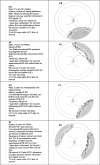Silicone assisted, argon laser confinement of recurrent proliferative vitreoretinopathy related retinal detachment: a technique to allow silicone oil removal in problem eyes
- PMID: 9422930
- PMCID: PMC1722303
- DOI: 10.1136/bjo.81.9.765
Silicone assisted, argon laser confinement of recurrent proliferative vitreoretinopathy related retinal detachment: a technique to allow silicone oil removal in problem eyes
Abstract
Aims/background: Recurrent peripheral retinal detachments may occur in eyes treated with vitrectomy and silicone oil for retinal detachments complicated by proliferative vitreoretinopathy (PVR). The aim of this study was to assess whether laser photocoagulation could be used in the presence of silicone oil to confine and stabilise recurrent PVR related peripheral retinal detachments enabling the timely removal of the oil.
Methods: 10 patients with recurrent peripheral retinal detachments after vitrectomy and silicone oil insertion were treated with posturing and subsequent focal argon laser to circumscribe the area of recurrent detachment.
Results: This technique alone was sufficient to limit the area of retinal detachment in seven of the cases. The remaining three cases required relieving retinotomies because of increasing retinal detachment despite the laser. In all 10 cases the silicone oil was later removed without progression of the detached areas.
Conclusion: Silicone assisted argon laser 'confinement' can be effective in stabilising eyes with peripheral retinal detachments allowing the subsequent removal of silicone oil.
Figures





Similar articles
-
STAINING-ASSISTED REMOVAL OF SILICONE OIL FOR THE IDENTIFICATION OF SUBCLINICAL PROLIFERATIVE VITREORETINOPATHY.Retina. 2017 Nov;37(11):2118-2123. doi: 10.1097/IAE.0000000000001441. Retina. 2017. PMID: 28045788
-
Retinotomy and silicone oil for detachments complicated by anterior inferior proliferative vitreoretinopathy.Br J Ophthalmol. 2009 Sep;93(9):1228-33. doi: 10.1136/bjo.2008.140988. Epub 2009 May 7. Br J Ophthalmol. 2009. PMID: 19429589
-
Deferred laser photocoagulation of relaxing retinotomies under silicone oil tamponade to reduce recurrent macular detachment in severe proliferative vitreoretinopathy.Graefes Arch Clin Exp Ophthalmol. 2014 Oct;252(10):1539-44. doi: 10.1007/s00417-014-2605-7. Epub 2014 Mar 18. Graefes Arch Clin Exp Ophthalmol. 2014. PMID: 24638256
-
[Treatment of vitreoretinal proliferation in rhegmatogenous detachment and silicone oil tamponade].J Fr Ophtalmol. 1996;19(2):97-105. J Fr Ophtalmol. 1996. PMID: 8731777 Review. French.
-
Silicone oil removal strategies.Semin Ophthalmol. 2000 Jun;15(2):88-91. doi: 10.3109/08820530009039998. Semin Ophthalmol. 2000. PMID: 11309741 Review.
Cited by
-
Risk factors for epiretinal membrane in eyes with primary rhegmatogenous retinal detachment that received silicone oil tamponade.Br J Ophthalmol. 2023 Jun;107(6):856-861. doi: 10.1136/bjophthalmol-2021-320121. Epub 2022 Feb 19. Br J Ophthalmol. 2023. PMID: 35184034 Free PMC article.
-
Nomogram for predicting non-proliferative vitreoretinopathy probability after vitrectomy in eyes with rhegmatogenous retinal detachment.Int J Ophthalmol. 2023 Feb 18;16(2):215-223. doi: 10.18240/ijo.2023.02.07. eCollection 2023. Int J Ophthalmol. 2023. PMID: 36816206 Free PMC article.
-
Timing and outcomes after silicone oil removal in proliferative vitreoretinopathy: a retrospective clinical series.Int J Retina Vitreous. 2015 Apr 15;1:2. doi: 10.1186/s40942-015-0002-y. eCollection 2015. Int J Retina Vitreous. 2015. PMID: 27847595 Free PMC article.
References
Publication types
MeSH terms
Substances
LinkOut - more resources
Full Text Sources
Medical
Research Materials
